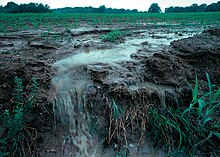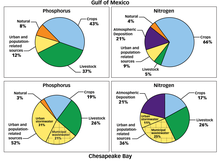Nutrient pollution caused by Surface runoff of soil and fertilizer during a rain storm
Nutrient pollution, a form of water pollution, refers to contamination by excessive inputs of nutrients. It is a primary cause of eutrophication of surface waters, in which excess nutrients, usually nitrogen or phosphorus, stimulate algal growth. Sources of nutrient pollution include surface runoff from farm fields and pastures, discharges from septic tanks and feedlots, and emissions from combustion. Excess nutrients have been summarized as potentially leading to:
- Population effects: excess growth of algae (blooms);
- Community effects: species composition shifts (dominant taxa);
- Ecological effects: food web changes, light limitation;
- Biogeochemical effects: excess organic carbon (eutrophication); dissolved oxygen deficits (environmental hypoxia); toxin production;
- Human health effects: excess nitrate in drinking water (blue baby syndrome); disinfection by-products in drinking water;
- Biodiversity effects: excessive algae blooms (biodiversity loss).
Sources
Agriculture is the major source of nutrient pollution in the Gulf of Mexico. In the Chesapeake Bay, agriculture is a major source, along with urban areas and atmospheric deposition.
Nitrogen
Use of synthetic fertilizers, burning of fossil fuels, and agricultural animal production, especially concentrated animal feeding operations (CAFO), have added large quantities of reactive nitrogen to the biosphere.Phosphorus
Phosphorus polllution is caused by excessive use of fertilizers and manure, particularly when compounded by soil erosion. Phosphorus is also discharged by municipal sewage treatment plants and some industries.Land uses
The principal source(s) of nutrient pollution in an individual watershed depend on the prevailing land uses. The sources may be point sources, nonpoint sources, or both:- Agriculture: animal production or crops
- Urban/suburban: stormwater runoff from roads and parking lots; excessive fertilzer use on lawns; municipal sewage treatment plants; motor vehicle emissions
- Industrial: air pollution emissions (e.g. electric power plants), wastewater discharges from various industries.
Mitigation of nutrient pollutant discharges
United States
Agricultural nonpoint source (NPS) pollution is the largest source of water quality impairments throughout the U.S., based on surveys by state environmental agencies. NPS pollution is not subject to discharge permits under the federal Clean Water Act (CWA). EPA and states have used grants, partnerships and demonstration projects to create incentives for farmers to adjust their practices and reduce surface runoff.Discharge permits
Many point source dischargers in the U.S., while not necessarily the largest sources of nutrients in their respective watersheds, are required to comply with nutrient effluent limitations in their permits, which are issued through the National Pollutant Discharge Elimination System (NPDES), pursuant to the CWA. Some large municipal sewage treatment plants, such as the Blue Plains Advanced Wastewater Treatment Plant in Washington, D.C. have installed biological nutrient removal (BNR) systems to comply with regulatory requirements. Other municipalities have made adjustments to the operational practices of their existing secondary treatment systems to control nutrients.Discharges from large livestock facilities (CAFO) are also regulated by NPDES permits. Surface runoff from farm fields, the principal source of nutrients in many watersheds, is classified as NPS pollution and is not regulated by NPDES permits.
TMDL program
A Total Maximum Daily Load (TMDL) is a regulatory plan that prescribes the maximum amount of a pollutant (including nutrients) that a body of water can receive while still meeting CWA water quality standards. Specifically, Section 303 of the Act requires each state to generate a TMDL report for each body of water impaired by pollutants. TMDL reports identify pollutant levels and strategies to accomplish pollutant reduction goals. EPA has described TMDLs as establishing a "pollutant budget" with allocations to each of the pollutant's sources. For many coastal water bodies, the main pollutant issue is excess nutrients, also termed nutrient over-enrichment.A TMDL can prescribe the minimum level of dissolved oxygen (DO) available in a body of water, which is directly related to nutrient levels. In 2010, 18 percent of TMDLs nationwide were related to nutrient levels including organic enrichment/oxygen depletion, noxious plants, algal growth, and ammonia.
TMDLs identify all point source and nonpoint source pollutants within a watershed. To implement TMDLs with point sources, wasteload allocations are incorporated into their NPDES permits. NPS discharges are generally in a voluntary compliance scenario.
In Long Island Sound, the TMDL development process enabled the Connecticut Department of Energy and Environmental Protection and the New York State Department of Environmental Conservation to incorporate a 58.5 percent nitrogen reduction target into a regulatory and legal framework.
Nutrient remediation
Mussels are examples of organisms that act as nutrient bioextractors
Innovative solutions have been conceived to deal with nutrient pollution in aquatic systems by altering or enhancing natural processes to shift nutrient effects away from detrimental ecological impacts. Nutrient remediation is a form of environmental remediation, but concerns only biologically active nutrients such as nitrogen and phosphorus. “Remediation” refers to the removal of pollution or contaminants, generally for the protection of human health. In environmental remediation nutrient removal technologies include biofiltration, which uses living material to capture and biologically degrade pollutants. Examples include green belts, riparian areas, natural and constructed wetlands, and treatment ponds. These areas most commonly capture anthropogenic discharges such as wastewater, stormwater runoff, or sewage treatment, for land reclamation after mining, refinery activity, or land development. Biofiltration utilizes biological assimilation to capture, absorb, and eventually incorporate the pollutants (including nutrients) into living tissue. Another form of nutrient removal is bioremediation, which uses microorganisms to remove pollutants. Bioremediation can occur on its own as natural attenuation or intrinsic bioremediation or can be encouraged by the addition of fertilizers, a strategy called biostimulation.
Nutrient bioextraction is bioremediation involving cultured plants and animals. Nutrient bioextraction or bioharvesting is the practice of farming and harvesting shellfish and seaweed for the purpose of removing nitrogen and other nutrients from natural water bodies. It has been suggested that nitrogen removal by oyster reefs could generate net benefits for sources facing nitrogen emission restrictions, similar to other nutrient trading scenarios. Specifically, if oysters maintain nitrogen levels in estuaries below thresholds that would lead to the imposition of emission limits, oysters effectively save the sources the compliance costs they otherwise would incur. Several studies have shown that oysters and mussels have the capacity to dramatically impact nitrogen levels in estuaries. Additionally, studies have demonstrated seaweed's potential to improve nitrogen levels.
History of nutrient policy in the United States
The basic requirements for states to develop nutrient criteria and standards were mandated in the 1972 Clean Water Act. Implementing this water quality program has been a major scientific, technical and resource-intensive challenge for both EPA and the states, and development is continuing well into the 21st century.EPA published a wastewater management regulation in 1978 to begin to address the national nitrogen pollution problem, which had been increasing for decades. In 1998, the agency published a National Nutrient Strategy with a focus on developing nutrient criteria.
Between 2000 and 2010 EPA published federal-level nutrient criteria for rivers/streams, lakes/reservoirs, estuaries and wetlands; and related guidance. "Ecoregional" nutrient criteria for 14 ecoregions across the U.S. were included in these publications. While states may directly adopt the EPA-published criteria, in many cases the states need to modfiy the criteria to reflect site-specific conditions. In 2004, EPA stated its expectations for numeric criteria (as opposed to less-specific narrative criteria) for total nitrogen (TN), total phosphorus (TP), chlorophyll a(chl-a), and clarity, and established "mutually-agreed upon plans" for state criteria development. In 2007, the agency stated that progress among the states on developing nutrient criteria had been uneven. EPA reiterated its expectations for numeric criteria and promised its support for state efforts to develop their own criteria.
In 2008 EPA published a progress report on state efforts to develop nutrient standards. A majority of states had not developed numeric nutrient criteria for rivers and streams; lakes and reservoirs; wetlands and estuaries (for those states that have estuaries). In the same year, EPA also established a Nutrient Innovations Task Group (NITG), composed of state and EPA experts, to monitor and evaluate the progress of reducing nutrient pollution. In 2009 the NTIG issued a report, "An Urgent Call to Action," expesssing concern that water quality continued to deteriorate nationwide due to increasing nutrient pollution, and recommending more vigorous development of nutrient standards by the states.
In 2011 EPA reiterated the need for states to fully develop their nutrient standards, noting that drinking water violations for nitrates had doubled in eight years, that half of all streams nationwide had medium to high levels of nitrogen and phosphorus, and harmful algal blooms were increasing. The agency set out a framework for states to develop priorities and watershed-level goals for reductions of nutrients.
Nutrient trading
After the EPA had introduced watershed-based NPDES permitting in 2007, interest in nutrient removal and achieving regional TMDLs led to the development of nutrient trading schemes. Nutrient trading is a type of water quality trading, a market-based policy instrument used to improve or maintain water quality. Water quality trading arose around 2005 and is based on the fact that different pollution sources in a watershed can face very different costs to control the same pollutant. Water quality trading involves the voluntary exchange of pollution reduction credits from sources with low costs of pollution control to those with high costs of pollution control, and the same principles apply to nutrient water quality trading. The underlying principle is “polluter pays”, usually linked with a regulatory driver for participating is the trading program.A 2013 Forest Trends report summarized water quality trading programs and found three main types of funders: beneficiaries of watershed protection, polluters compensating for their impacts and ‘public good payers’ that may not directly benefit, but fund the pollution reduction credits on behalf of a government or NGO. As of 2013, payments were overwhelmingly initiated by public good payers like governments and NGOs.



